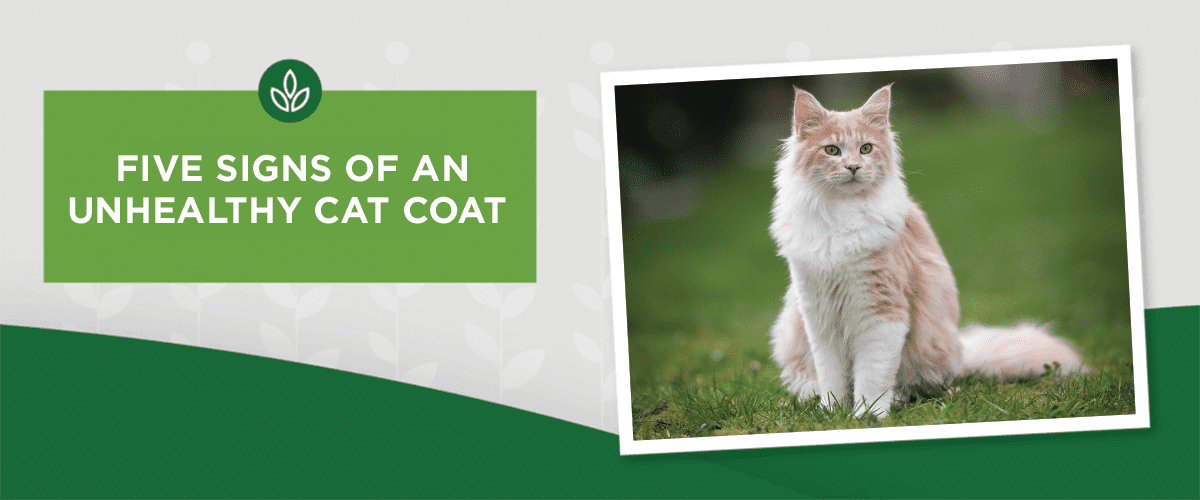Five Signs of an Unhealthy Cat Coat
Cats can’t verbally tell us when they aren’t feeling their best. However, pet parents can learn a lot about their cats’ health by simply looking at their feline friends. One indicator of a healthy cat is a shiny, vibrant coat. If your pet’s fur is looking a little dull, it may indicate a larger health problem.
But what exactly does a lackluster cat coat look like? Below we’ll discuss common signs of an unhealthy cat coat and provide helpful tips to keep your pet’s fur soft and shiny.
Types of Cat Fur
Like humans, cats don’t all have the same hair. Understanding the different types of cat fur will make it easier to identify if your feline friend is dealing with an unhealthy coat.
Long-Haired Cats
Long-haired cats, like Maine Coons and Persians, grow their hair between two and five inches in length. Healthy fur on these breeds should be shiny and tangle-free.
Short-Haired Cats
Short-haired cats, like Bengals and Bombays, have short sleek fur that rarely reaches two inches. A healthy short coat on a cat should be smooth, glossy, and lie flat against their body.
Curly-Haired Cats
Curly-haired cats, like LaPerms or Devon Rexs, can have short or long hair. Their fur’s unique characteristic is the distinctive curly pattern. A healthy coat on a curly-haired cat should showcase well-defined curls that are uniform and free of matting or tangling.
Signs of an Unhealthy Cat Coat
Dull Coat
If your once vibrant cat is now sporting lackluster fur, it’s more than just a cosmetic concern. A dull coat might signify a nutritional deficiency, and it could mean it’s time to examine your cat’s diet.
Matted Fur
Cats, especially those with longer coats, are prone to matting, causing discomfort, skin irritation, and even restricting movement. Ignoring this issue can lead to discomfort, skin infections, or more serious health concerns.
Patchy Coat
A patchy coat could point to various underlying issues, including allergies, fungal infections, or hormonal imbalances. Unexpected patchiness accompanied by redness or inflammation warrants close attention and a trip to the vet.
Under-grooming
Cats are known for their meticulous grooming routines, so if you notice your cat is no longer grooming themselves, it may be cause for concern. Undergrooming might be linked to health problems like arthritis, dental pain, or even stress. Additionally, senior cats or those with mobility issues may struggle with grooming due to physical limitations.
Over-grooming
While grooming is a natural behavior for cats, overgrooming can raise eyebrows for pet parents. Cats exhibiting excessive grooming might be grappling with more than just a bad habit. Common causes of overgrooming include skin infections, fleas, and parasites.
How to Improve Your Cat’s Coat
If you notice your cat’s coat exhibits any of the signs listed above, it’s important to talk with your vet. Doing so will help you determine the root cause of their fur problems so you can take the proper steps to help them get their shine back and coat back in good health. To help prevent future fur problems, check out the tips below.
Feed Your Cat a High-Quality Diet
One of the most effective ways to promote a lustrous coat is by feeding them a nutritious, high-quality diet. When selecting cat food, prioritize options that list a protein source as the main ingredient. Your cat’s coat is compromised almost entirely of protein, so prioritizing protein in their diet can help keep their fur healthy.
If you’re looking for a new cat food option, remember all Nature’s Logic cat recipes utilize protein as their main ingredient, allowing your cat to get the nutrients they need to thrive. For additional coat support, check out our Feline Duck & Salmon Feast or our Feline Sardine Meal Feast. Both recipes contain fish rich in omega-3s as the first ingredient. These fatty acids help nourish the skin and promote vibrant fur.
Give Them a Hand With Grooming
While cats are typically meticulous self-groomers, sometimes they need a little extra help, especially if they are aging or experiencing health issues. Brushing your cat helps removes loose fur, prevents matting, and strengthens your bond with your feline friend.
For short-haired cats, a soft-bristle brush or grooming mitt removes loose hair and keeps their coat sleek. For long-haired cats, invest in a quality cat brush with longer bristles to prevent tangles and matting. Curly-haired cats may benefit from regular brushing to maintain the definition of their unique curls.
Keeping Your Cat’s Fur Healthy
How your pet looks on the outside can tell you a lot about how they are doing on the inside. Keep your cat happy and healthy with the help of all natural cat food. For more information on where you can find an all natural cat food option, check out our store locator.





